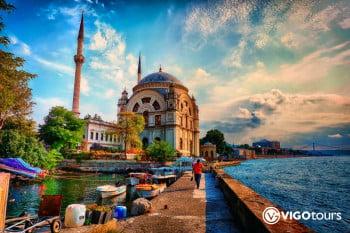Hagia Sophia (Ayasofya) is one of the most significant architectural achievements in history, reflecting the grandeur of both Byzantine and Ottoman empires. Originally constructed as a cathedral in the 6th century, it has served various religious purposes over the centuries, making it a symbol of Istanbul's rich cultural heritage. Today, Hagia Sophia stands as a museum, attracting millions of visitors who come to admire its breathtaking architecture and historical significance.
1. A Brief History
Overview: The historical significance of Hagia Sophia
Hagia Sophia was commissioned by Emperor Justinian I in 532 AD and completed in just five years. It served as the cathedral of Constantinople and the center of Eastern Orthodox Christianity for nearly 1,000 years. Following the Ottoman conquest of Constantinople in 1453, it was converted into a mosque by Sultan Mehmed II, who added minarets and Islamic calligraphy. In 1935, it was secularized and transformed into a museum, showcasing its architectural beauty and historical artifacts. In 2020, Hagia Sophia was reconverted into a mosque, continuing its legacy as a place of worship.
2. Architectural Features
Overview: The design and elements of Hagia Sophia
Hagia Sophia is renowned for its groundbreaking architectural design, which has influenced countless structures throughout history:
- Dome: The most striking feature of Hagia Sophia is its massive dome, which appears to float above the central nave. Measuring 31 meters in diameter and 55 meters high, the dome is supported by pendentives—an innovative architectural solution that allows for a circular dome to rest on a square base. The interior of the dome is adorned with intricate mosaics and decorative elements that create a sense of ethereal beauty.
- Mosaics: The walls of Hagia Sophia are richly decorated with stunning mosaics depicting Christian iconography, including images of Christ, the Virgin Mary, and various saints. These mosaics were created during the Byzantine era and are a testament to the artistic excellence of the period. After the mosque conversion, many mosaics were covered but have since been restored and can be seen today.
- Interior Space: The vast interior of Hagia Sophia is characterized by a harmonious blend of architectural elements. The central nave is flanked by two aisles, and the use of light plays a crucial role in enhancing the space's grandeur. The numerous windows at the base of the dome allow sunlight to filter in, creating a magical atmosphere.
3. Visiting Hagia Sophia
Overview: What to expect during your visit
A visit to Hagia Sophia offers a unique opportunity to explore its rich history and architectural beauty:
- Entrance and Admission: Hagia Sophia is located in Sultanahmet, making it easily accessible to visitors. Admission is free, but donations are welcomed to support the upkeep of the mosque.
- Guided Tours: To fully appreciate the history and significance of Hagia Sophia, consider joining a guided tour. Knowledgeable guides provide insights into the architectural features, historical events, and the significance of various artworks.
- Respectful Behavior: As a functioning mosque, visitors are expected to dress modestly and behave respectfully. Women may be required to cover their heads, and shoes should be removed before entering the prayer area.
4. Practical Tips for Visiting
Overview: Ensuring a smooth visit to Hagia Sophia
To make the most of your experience at Hagia Sophia, consider these practical tips:
- Opening Hours: Hagia Sophia is open to visitors during prayer times, so it’s advisable to check the prayer schedule in advance. The general visiting hours are typically from 9 AM to 7 PM, but hours may vary.
- Best Time to Visit: To avoid crowds, consider visiting early in the morning or later in the afternoon. Weekdays are generally less crowded than weekends.
- Photography: Photography is allowed, but be mindful of the privacy of worshippers and the sacredness of the space. Avoid using flash in the prayer areas.
5. Cultural Significance
Overview: The importance of Hagia Sophia in history
Hagia Sophia is not only an architectural masterpiece but also a symbol of the cultural and religious transitions that have shaped Istanbul over the centuries. It reflects the historical relationship between Christianity and Islam, showcasing the artistic and architectural achievements of both religions. The site has been a focal point of pilgrimage, worship, and cultural exchange for centuries, making it a vital part of Istanbul’s identity.
Read here: Things to do in istanbul
Conclusion
A visit to Hagia Sophia is a journey through time, offering a unique glimpse into the rich history of Istanbul and the architectural brilliance of the Byzantine and Ottoman empires. Its breathtaking dome, intricate mosaics, and historical significance make it a must-visit destination for anyone exploring the city. As you stand beneath the magnificent dome of Hagia Sophia, you’ll find yourself enveloped in the stories of an empire that once spanned continents, leaving behind a legacy of beauty and resilience that continues to inspire awe.
